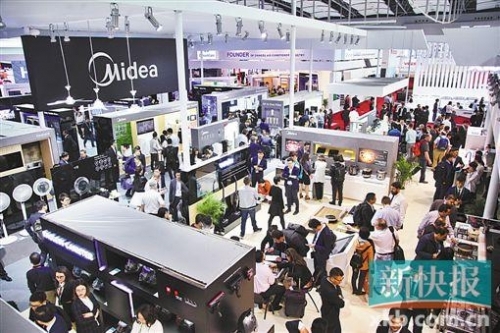
The 123rd China Import and Export Fair.
China's industrial robots have fewer imports, fewer low-end and more high-end products, and how the robots at the Canton Fair can tell stories
In the context of economic restructuring and rising labor costs, the global robot market demand continues to increase. "Made in China 2025" also explicitly included industrial robots as one of the ten key areas for the promotion of breakthrough development. At the 123rd Canton Fair, there were robot booths on the electromechanical exhibition area.
Canton Fair Robot Booth Popularity
At the 123rd Canton Fair, there were robot booths on the electromechanical exhibition area.
Xuzhou Libo Foreign Trade Co., Ltd., which has been exhibiting at the Canton Fair for 20 years, displayed only one product at the booth this time – the world’s first 6-degree-of-freedom bending robot, and saw a yellow robot rule quickly and quickly. The iron plates were bent and stacked neatly aside, attracting several buyers to look around.
According to the person in charge, Zhang Feng, this robot has been optimized for the bending conditions to solve the problem of bending follow-up deviation and long teaching time caused by the large acceleration of the plate bending process. The processing speed is faster and the accuracy is higher. higher. The robot has approached nearly 400 overseas buyers in just three days. Zhang Feng admitted that domestic robotics technology is currently only in the second echelon, and there is still a certain gap between the first echelon of Japan and Germany. Therefore, his target customers are Eastern Europe, South America and Australia.
Imports and exports have less trade deficits
According to relevant statistics, as China's demographic dividend has weakened and Industry 4.0 has advanced, China's manufacturing industry has embarked on an era of increased efficiency through automation and has become the largest market for robots worldwide. Although in recent years, China's robotics technology has advanced rapidly and domestic brands have risen, the robots produced in China are still relatively backward, presenting the status of less imports, more exports, and low-end, high-end, less-expensive trade balances.
According to a report compiled by the General Administration of Customs of the People's Republic of China on prospective industry research institutes, according to the report compiled by the General Administration of Customs of the People's Republic of China, in 2016, the total value of imports and exports of China's industrial robotics industry was US$112.129 million, an increase of 8.80% year-on-year, of which imports amounted to US$9,960.8975 million, an increase of 9.07% year-on-year. It was US$1,601.055 million, an increase of 7.20% year-on-year, and the trade deficit was 336.7318 million US dollars, a year-on-year increase of 9.45%. According to the latest data tracked by OFweek Industry Research Center, the number of imported industrial robots in China increased by nearly 32,000 units in 2017, but the export volume has shrunk by about 3%. Among them, Japan continues to maintain its position as the largest importer of industrial robots in China, accounting for 81% of the total, followed by South Korea and Germany, both of which received a share of about 10% of imports.
In terms of prices, in the two years of domestic industrial robots' export volume in 2016 and 2017, the export unit price of industrial robots in China was significantly lower than the import unit price. In 2016, the unit prices for imports and exports were US$16,300/set and US$5,100/set respectively, and the unit prices for imports and exports in 2017 were US$15,300/set (sets) and US$7,600/set respectively.
According to statistics, the output of industrial robots in China was 130,000 sets (sets) in 2017, an increase of 81.0%, but the sales volume of domestic branded industrial robots did not match the market demand in China. Integrated multiple market data, the current domestic industrial robot market accounted for about 30%, high-end applications, industrial robots domestic brand market share of less than 5%.
Home appliance giant layout hopes to enhance the industry
In recent years, home appliance giants such as Haier, Gree, and Midea have all made a transition to intelligent manufacturing, which is expected to boost the overall upgrade of the Chinese robotics industry.
Gree Group began to implement “machine substitution†from the end of 2012. In just two or three years, the investment reached a scale of 10 billion yuan. The robot became Dong Mingzhu’s favorite story “for the first time†and for the first time, “the second owner of Gree Electric Appliances in the futureâ€. Industry "to position the strategic significance of smart equipment. Its own research and development of Gree industrial robot in addition to welding, assembly, handling, palletizing and other professional skills, but also play drums, basketball, dance, sculpture, etc., can be said to have on stage, under the factory. Coincidentally, in early March, the United States released the "new generation of man-machine" strategy. At the same time, Haier also officially released "Haier Smart Home - Service Robot Strategy 1.0."
With the expansion of home appliance giants and some vertical professional companies, industry organizations predict that in the next three years, the output of domestic industrial robots will double on the current basis, and by 2020 the domestic industrial robot production will exceed 250,000 units. Industry analysts believe that home appliance giants have strong financial strength and huge technical R&D strengths, and see if they can lead the Chinese robotic industry to achieve the myth of domestic white electricity export counterattacks in the past century.
Planetary Geared Servo Motor,Gearbox Servo Motor,Reducer Servo Motor,Planetary Gearbox Servo Motor
Zhejiang Synmot Electrical Technology Co., Ltd , https://www.synmot-electrical.com